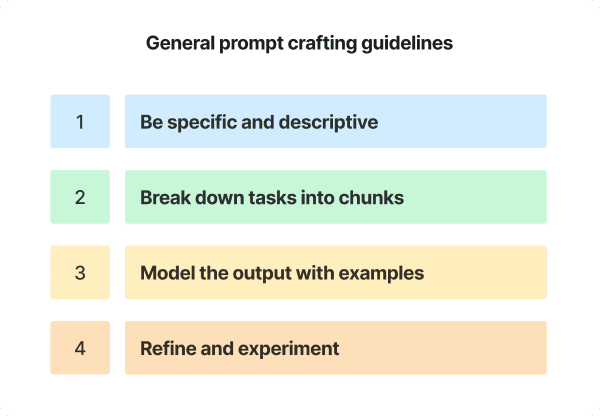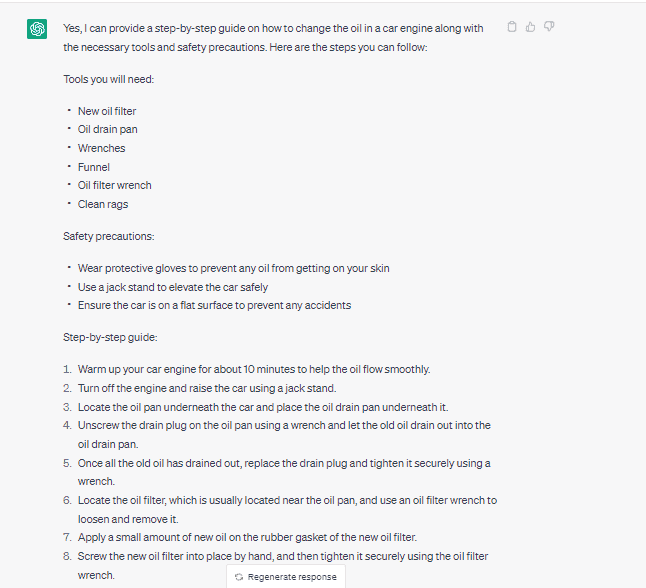GET A FREE CUSTOMIZED ADVANCED SEO AUDIT & DIGITAL MARKETING STRATEGY NOW!
As technology continues to advance, so does the need for intelligent conversational AI. One of the key components of such AI is the prompt. Prompts are a critical component of any language model or chatbot. They are the starting point for generating responses to user queries and initiating conversations. In this article, we will explore the basics of prompt optimization and engineering and the future of this field.

⭐️What Is A Prompt?
Simply simply, prompting is the method by which a user connects with AI products. You may “tell” the AI what you want and how you want it done via prompts. You’re simply describing what you want to see as a result of a prompt.
For example, if you want to produce an image but don’t have a reference image, you can tell the AI how you want the image to look. Consider it like describing a painting to an artist who can turn your concept into an actual image. You’ll most likely use clear and explicit details when describing the image you want from the artist.
Also if you want to receive an specific response to a question in a specific style, then you can tell the AI to answer in that way, for example, words like “explain in simple terms”, “explain in layman terms” or defining the tone of the voice in a prompt helps to generate custom responses that are tailored to the user’s needs.
The same logic applies to AI technologies such as ChatGPT And DALL E2.
⭐️What Is The Main Difference Between A Good Prompt And A Bad Prompt?
The main difference between a good prompt and a bad prompt is how well it elicits the desired response from the user. A good prompt is one that is clear, concise, and easy to understand. It should be relevant to the user’s needs, and should be presented in a way that encourages the user to provide a detailed response.
On the other hand, a bad prompt is one that is vague, confusing, or irrelevant. It may be presented in a way that is intimidating or off-putting to the user, making them less likely to provide the information that is needed.
⭐️Here is an example:
⭐️Bad Prompt

If you are a layman in blockchain who just want to understand it, perhaps this answer won’t help you much. This is an example of a bad prompt in this case. The words used are highly technically and definitely not suitable for a person trying to understand blockchain.
However here is an example of how the same prompt can be engineered to give the desired result.
⭐️Good Prompt

As seen from the above screenshot, this prompt give a better overview of blockchain and does it in layman terms. Did you understand the difference in the prompt style?
⭐️What is Prompt Engineering?
Prompt engineering is the process of creating and refining prompts to optimize the performance of a language model or chatbot. A prompt is a piece of text that provides context and guidance for generating a response to a user query. It typically consists of a short phrase or sentence that describes the desired outcome of the conversation.
⭐️How Can Prompt Engineering Improve The User Experience?
Prompt engineering is the process of designing prompts that are optimized for maximum effectiveness. This includes analyzing user data to determine what prompts are most effective, and using that data to create prompts that are tailored to the specific needs of each user.
By improving the effectiveness of prompts, prompt engineering can improve the overall user experience. Users are more likely to engage with AI systems that present clear, concise prompts that are relevant to their needs. This, in turn, can lead to more accurate and useful data for businesses and organizations.
⭐️Basic Tips To Prompt Engineering
Effective prompt engineering involves selecting the right prompts for a particular use case, refining prompts to improve performance, and using markup language to structure and format prompts effectively.
⭐️Selecting the Right Prompts
The first step in prompt engineering is selecting the right prompts for a particular use case. This involves understanding the user’s needs and the context in which they will be using the language model or chatbot. For example, if the user is seeking information about a particular topic, the prompt should be designed to elicit that information.
⭐️Refining Prompts for Better Performance

Once the appropriate prompts have been selected, the next step is refining them to improve performance. This involves analyzing the prompts’ effectiveness in generating relevant responses and iterating on them to make them more effective.
One way to refine prompts is to analyze the responses generated by the language model or chatbot and identify patterns in the prompts that lead to successful outcomes. These patterns can then be used to guide the refinement of future prompts.
⭐️Using Markup Language to Structure and Format Prompts
Markup language can be used to structure and format prompts effectively, making them more readable and understandable to users. Common markup languages used in prompt engineering include HTML and Markdown.
HTML can be used to structure prompts into headings and paragraphs, and to add links and other interactive elements. Markdown, on the other hand, is a simpler markup language that can be used to add headings, bold and italic text, and other formatting options.
⭐️Concrete Order of Operations
Here is an example:
“Can you provide a step-by-step guide on how to change the oil in a car engine? Please include the necessary tools and safety precautions.”

Look at the result!
A concrete order of operations is essential in prompt engineering to ensure that prompts are generated and processed efficiently. This involves specifying the order in which prompts should be presented to users and the steps that should be taken to generate a response to a user query.
The concrete order of operations should take into account the user’s needs, the context in which the language model or chatbot is being used, and any technical limitations or constraints.
⭐️Including Tone for Prompt Engineering
Tone is an essential element of prompt engineering, as it helps to set the tone for the conversation and establish the relationship between the user and the language model or chatbot.
Tone can be used to convey a sense of friendliness, professionalism, or authority, depending on the context and the needs of the user. For example, a language model or chatbot used in customer support should adopt a tone that is empathetic and helpful, while a language model or chatbot used in a professional setting should adopt a more formal tone.
⭐️Some examples:

As you can see the first line of the prompt sets the tone for the conversation. This is called AI model tuning and is often essential while interacting with natural language models.
⭐️What Are Some Best Practices For Prompt Engineering?
There are several best practices that can be used to optimize prompts for maximum effectiveness. These include:
- Use natural language: Prompts should be written in natural language that is easy for users to understand. Avoid using overly formal or stilted language, as this can create a sense of distance between the user and the prompt. Consider the user’s demographic when crafting the language of the prompt; for example, using slang or colloquialisms might be appropriate for a younger audience. Use active voice and straightforward sentence structures to make the prompt easy to follow.
- Keep it simple: Prompts should be clear and concise, and should avoid unnecessary complexity or detail. Prioritize the most important information in the prompt, and leave out anything that is not directly relevant to the user’s needs. Use bullet points or numbered lists to break up complex information and make it easier to digest. Consider the user’s level of familiarity with the subject, and adjust the level of detail accordingly.
- Be specific: Prompts should be specific to the user’s needs, and should be tailored to their individual preferences and interests. Use personalization wherever possible to make the prompt feel tailored to the user’s unique situation. Provide clear instructions on how the user can act on the prompt, whether that involves clicking a button or completing a form. Use data and insights to inform the content of the prompt, and ensure that it aligns with the user’s goals and motivations.
- Use visuals: Visuals can help to clarify complex prompts, and can make the user experience more engaging. Consider using videos, images, or infographics to convey complex information in a more engaging way. Use consistent branding and design elements to make the prompt feel cohesive with the rest of the user experience. Test different types of visuals to see which ones resonate most with users.
- Test and iterate: Prompts should be tested and refined over time to ensure maximum effectiveness. Use A/B testing to compare the effectiveness of different prompts, and make data-driven decisions about which ones to use. Solicit feedback from users on their experience with the prompts, and use that feedback to inform future iterations. Continuously monitor the performance of the prompts and make adjustments as needed to ensure they are always optimized for maximum effectiveness.
⭐️What is the Future of Prompt Engineering?
As AI technology continues to evolve, prompt engineering will become an increasingly important field. The ability to design effective prompts that elicit accurate and useful information from users will be essential for businesses and organizations that rely on AI systems for data collection and analysis.
In the future, prompt engineering may be integrated with other AI technologies, such as natural language processing and machine learning, to create even more sophisticated conversational AI systems. These systems will be able to understand and respond to user input in more complex and nuanced ways, leading to even more accurate and useful data.
Overall Prompt Engineering can have a significant impact on the productivity and time for businesses.
- Faster response times to user queries and requests
- Reduction in workload for professionals, especially in customer service and support roles
- Improved accuracy and reliability of AI systems, leading to better decision making
- Streamlined data analysis and research processes, resulting in faster insights and outcomes
- Greater overall efficiency and effectiveness of AI systems in various industries
Conclusion
Prompt optimization and engineering is an essential component of intelligent conversational AI. By designing effective prompts that are tailored to the specific needs of each user, businesses and organizations can improve the accuracy and usefulness of the data they collect. As AI technology continues to advance, prompt engineering will become an increasingly important field, with the potential to revolutionize the way we interact with AI systems.

